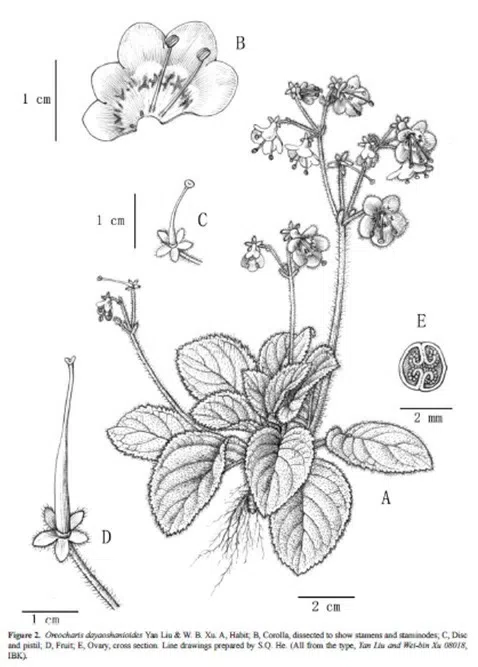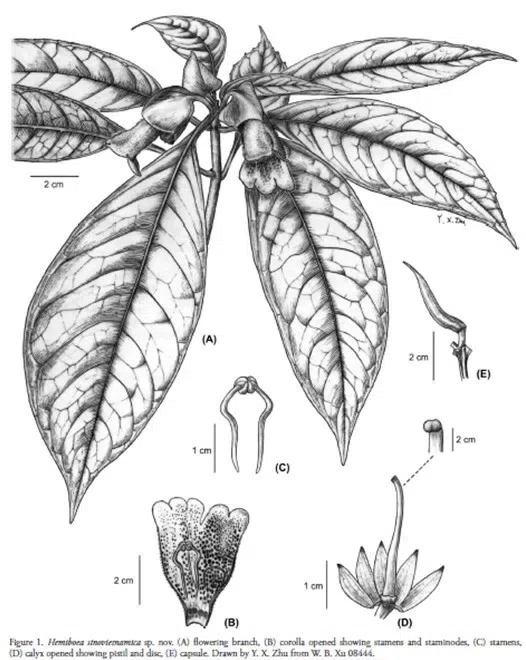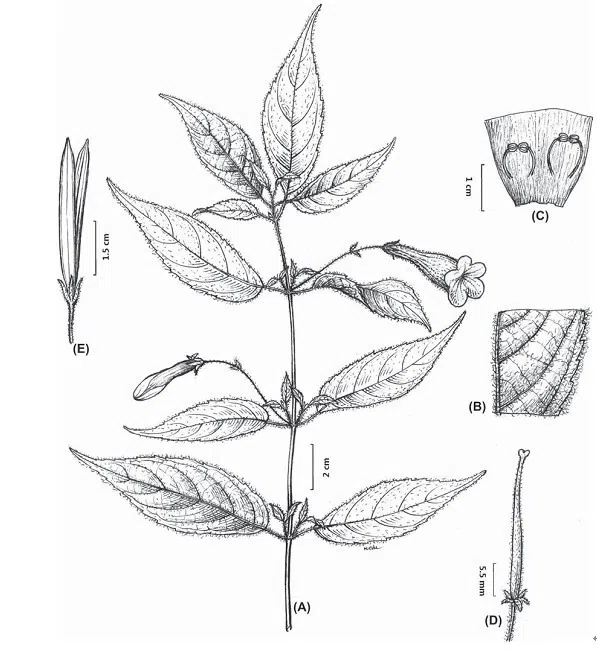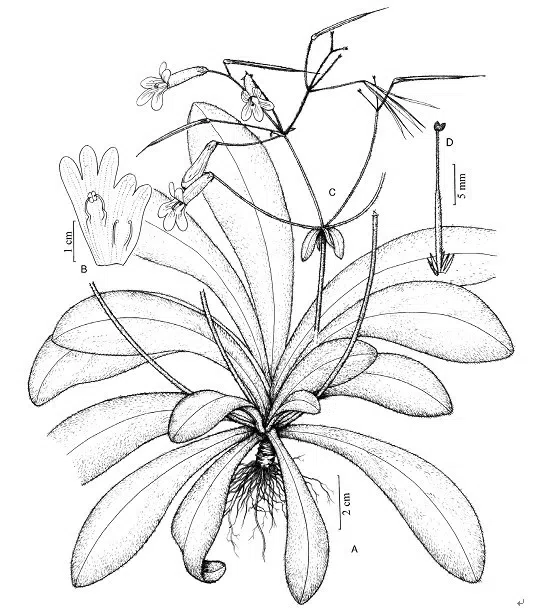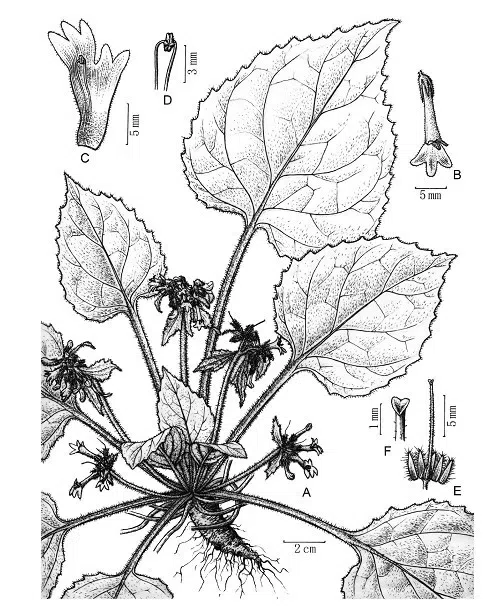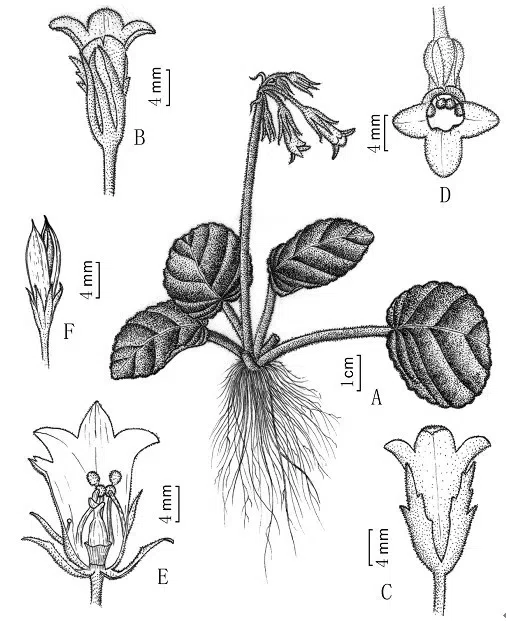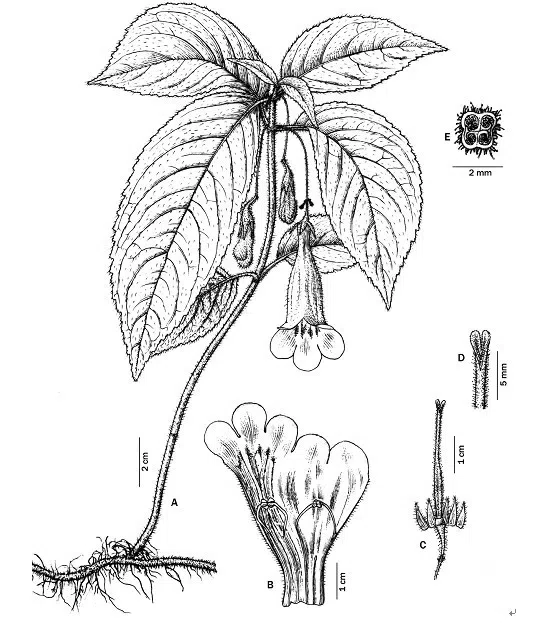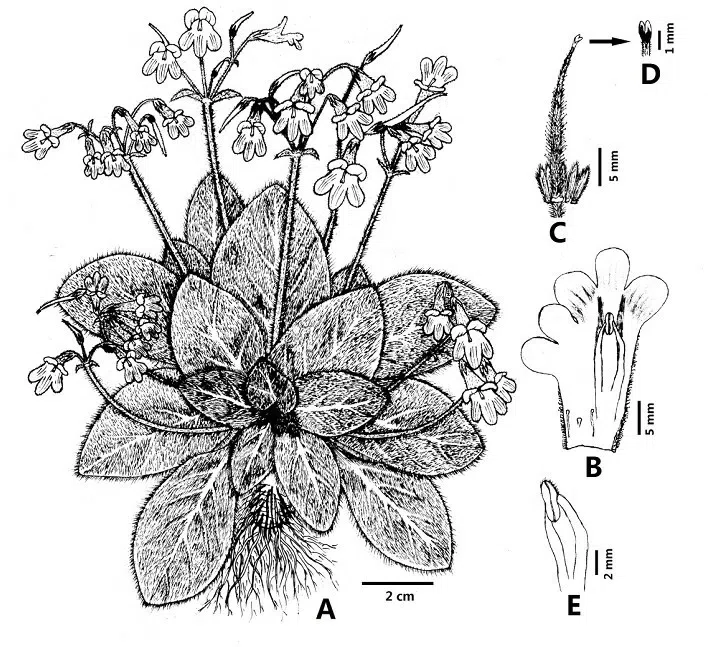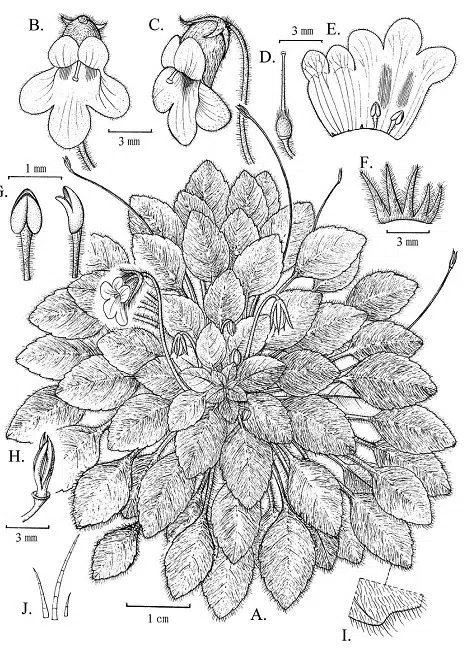No. 1 Wei-Bin XU, Bo PAN, Yan LIU, Ching-I PENG and Kuo-Fang CHUNG: Two new species, Primulina multifida and P. pseudomollifolia (Gesneriaceae), from karst caves in Guangxi, China. —Botanical Studies 53: 165-175.
ABSTRACTPrimulina pseudomollifolia W.B. Xu & Yan Liu and P. multifida B. Pan & K.F. Chung from karst caves in Guangxi Zhuangzu Autonomous Region, China are described and illustrated as two new species. Their generic placement in the recently recircumscribed Primulina is supported by phylogenetic analyses of DNA sequence nuclear ITS and chloroplast trnF-L intron spacer regions. Primulina pseudomollifolia is similar to P. mollifolia (D. Fang & W. T. Wang) J.M. Li & Y.Z. Wang in being densely pubescent on both blade surfaces, but differs in the base of its blades being cuneate to broadly cuneate, its 12-14 mm long white to pink corolla 8-9 mm long tubular corolla tube, 5-6 mm long filaments, 3 staminodes, and flowering from July to September. Primulina multifida resembles P. renifolia (D. Fang & D. H. Qin) J. M. Li & Y. Z. Wang, but differs in the blade margins being pinnatifid; its ovate to broadly ovate bracts, 3-4 × 1.5-2 mm, 5-7 mm long tubular corolla tube, 3-5 mm long filaments, 3 staminodes, linguiform stigma, and flowering from June to August.
Where can you get this paper or available information? More beautiful color pictures are shown in this paper.
Link: http://ejournal.sinica.edu.tw/bbas/content/2012/1/Bot531-15.pdf
No. 2 Yan LIU, Wei-Bin XU, Yu-Song HUANG, Ching-I PENG and Kuo-Fang CHUNG: Oreocharis dayaoshanioides, a rare new species of Gesneriaceae from eastern Guangxi, China. Botanical Studies 53: 393-399.
ABSTRACTOreocharis dayaoshanioides Yan Liu & W. B. Xu, a new species of Gesneriaceae from Guangxi, China, is described and illustrated. This new species is most similar and closely related to Oreocharis cotinifolia (W. T. Wang) Mich. Möller & A. Weber (=Dayaoshania cotinifolia W.T. Wang), differing from the latter by the distinctly serrulate leaf margin, much branched cymes, smaller and numerous flowers with abaxial lipped-lobes being broadly ovate to orbicular-ovate, and a glabrous pistil. The new species is extremely rare, currently known only from one site in eastern Guangxi.
The figure was cited from Liu et al. (2012).
More beautiful color pictures were shown in this paper. Where can you get this paper or available information?
Link: http://ejournal.sinica.edu.tw/bbas/content/2012/3/Bot533-12.pdfNo. 3 Wei-Bin Xu, Yu-Song Huang, Ri-Cheng Peng and Xue-Ying Zhuang: Hemiboea sinovietnamica sp. nov. (Gesneriaceae) from a limestone area along the boundary of Sino-Vietnam —Nordic Journal of Botany 30: 691–695.
ABSTRACTHemiboea sinovietnamica W. B. Xu & X. Y. Zhuang, a new species of Gesneriaceae from a limestone area along the boundary of Sino-Vietnam, is described and illustrated. The new species is similar to H. longgangensis Z. Y. Li with its yellowish corolla, but differs in having leaf blades glabrous on both sides, involucre trigonous, 2–3 cm in diameter, glabrous outside, glabrous cymes, a white calyx that is glabrous outside, and glabrous pistil and capsule.
The figure was cited from Xu et al. (2012).
More beautiful color pictures were shown in this paper.
Where can you get this paper or available information?
Link: http://ejournal.sinica.edu.tw/bbas/content/2012/3/Bot533-12.pdf or you can email the authors for this paper. The corresponding author's email is xyzhuang@scau.edu.cn.
No. 4 Vu Xuan Phuong , Do-Thi Xuyen , Fang Wen and Yi-Gang Wei: Raphiocarpus tamdaoensis sp. nov. (Gesneriaceae) from Vietnam —Nordic Journal of Botany 30: 696–699.
ABSTRACTA new species of Gesneriaceae, Raphiocarpus tamdaoensis V. X. Phuong, D. T. Xuyen & Y. G. Wei, is described and illustrated from Vietnam. It is similar to R. asper (Drake) B. L. Burtt and R. evrardii (Pellegr.) B. L. Burtt, but is easily differentiated by leaf blades being ovate–elliptic or obovate, 4–10 × 1.5–3.5 cm, one cyme with only one flower, peduncle linear, 3.0–5.0 cm long, corolla light yellow, 3.0–4.5 cm long, and a pubescent ovary.
Figure 1. Raphiocarpus tamdaoensis sp. nov. (A) habit, with fl owering branch, (B) piece of abaxial leaf blade, (C) corolla, opened with stamens exposed, (D) ovary, (E) ripe capsule with valves split. Drawn by L. K. Chi based on the holotye, Tran The Bach and Bui Thu Ha Bach-Ha 19, HN.
The figure was cited from Vu et al. (2012).
Where can you get this paper or available information?
Link: http://onlinelibrary.wiley.com/doi/10.1111/j.1756-1051.2012.01361.x/abstract?deniedAccessCustomisedMessage=&userIsAuthenticated=false.No. 5 Fang Wen, Shi-Li Xi, Yue Wang, Mei-Shu Xiang & Long-Fei Fu: Primulina fengshanensis (Gesneriaceae), a new species from Guangxi, China — Annales Botanici Fennici 49: 103–106.
ABSTRACT
Primulina fengshanensis Fang Wen & Yue Wang, a new species of Gesneriaceae from Guangxi, is described and illustrated. The new species is compared with the similar P. linearifolia and P. longgangensis, but differs e.g. by its fleshy leaves, apex of leaf blades ovate or rotund, and by two pairs bracts and pairwise opposite.
Fig. 1. Primulina fengshanensis (from the holotype, drawn by A. L. Li). — A: Habit. — B: Corolla opened with stamens and staminodes. — C: Inflorescence with flowers and fruits. — D: Calyx and pistil.
The figure was cited from Wen et al. (2012).Where can you get this paper or available information?
Link: http://www.sekj.org/anb/anb491-2.htm
No. 6 Yu-Song Huang, Wei-Bin Xu, Lei Wu & Yan Liu: Primulina gongchengensis (Gesneriaceae), a new species from Guangxi, China —Annales Botanici Fennici 49: 107–110.
ABSTRACTPrimulina gongchengensis Y.S. Huang & Yan Liu (Gesneriaceae) is described and illustrated as a new species from Guangxi, China. It is similar to P. macrodonta, but its leaves are densely glandular-pubescent on both surfaces, with a cuneate or broadly cuneate base and a repand or crenate margin; densely glandular-pubescent petiole and peduncle; purple corolla, with the tube ca. 1.5 cm long, 6–8 mm in diam. at the mouth; ca. 2 mm long, glabrous anthers; 3 staminodes, the lateral ones 1 mm long and the middle one 0.5 mm long; 1.5–1.8 cm long pistil; ca. 4 mm long ovary; and ca. 1 mm long stigma.
Fig. 1. Primulina gongchengensis (from the holotype, drawn by Y. X. Zhu). — A: Habit. — B: Flower. — C: Corolla opened showing stamens. — D: Stamens. — E: Pistil and calyx. — F: Stigma.
The black-white line figure was cited from Huang et al. (2012).
Where can you get this paper or available information? Link: http://www.sekj.org/anb/anb491-2.htmNo. 7 Wen-Hong Chen, Yu-Min Shui, Chao-Lang Hua, Chang-Yuan Yu & Kai Wen: Ancylostemon Dimorphosepalus (Gesneriaceae), a New Species from China. Annales Botanici Fennici 49(5-6):391-394.
ABSTRACTA new species of Gesneriaceae, Ancylostemon dimorphosepalus W.H. Chen & Y.M. Shui, is described and illustrated. It is characterized by its cordate leaves, purple flowers, dimorphous sepals, and small upper lobes of the corolla. Its relationships with the similar species, Ancylostemon aureus and Oreocharis rotundifolia, are discussed.
Fig. 2. Ancylostemon dimorphosepalus (A–E) from the holotype, F from Y. M. Shui et al. 85042, drawn by Kai Wen). — A: Habit. — B: Adaxial view of flower showing adaxial sepals. — C: Abaxial view of flower showing abaxial calyx lobes. — D: Face view of flower showing corolla lobes. — E: Opened flower showing stamens, ovary, stigma, disc and staminode. — F: Capsule with dry calyx lobes.
The figure was cited from Cheng et al. (2012).
Where can you get this paper or available information?
Link: http://www.bioone.org/doi/abs/10.5735/085.049.0612?journalCode=anbf
No. 8 Lei Wu, Bo Pan, Jin-Cai Yang & Wei-Bin Xu: Briggsia damingshanensis (Gesneriaceae), a new species from Guangxi, China. Annales Botanici Fennici 49(1-2):79-82.
ABSTRACTBriggsia damingshanensis L. Wu & B. Pan is described and illustrated as a new species of Gesneriaceae from Guangxi, China. It is similar to B. dongxingensis, but differs in its densely glandular-pubescent ovary, inconspicuous or absent bracts, pendulous and very slender peduncle, and sparsely pubescent stem and petiole.
Fig. 1. Briggsia damingshanensis (from the holotype, drawn by Y. X. Zhu). — A: Habit. — B: Corolla opened, showing stamens and staminodes. — C: Calyx and pistil. — D: Stigma lobes. — E: Cross section of ovary.
The black-white line figure was cited from Wu et al. (2012).
Where can you get this paper or available information?Link: http://www.bioone.org/doi/abs/10.5735/085.049.0111?journalCode=anbf
No. 9 FANG WEN, WENLAN LI, BO ZHAO, GUI-YOU LIANG AND YI-GANG WEI: Primulina purpurea F. WEN, B. ZHAO & Y.G WEI (GESNERIACEAE), A NEW SPECIES FROM CHINA. Bangladesh J. Plant Taxon. 19(2): 167-172.
ABSTRACTPrimulina purpurea F. Wen, B. Zhao & Y.G Wei, a new species from East Guangxi, China, is described and illustrated. The new species resembles P. medica (D. Fang) Y. Z.Wang, but differs from the latter by having broadly ovate to elliptic, left-right slightly asymmetry leaf blade, brightly purple to fuchsia corolla, broadly lanceolate to narrowly ovate bracts with villous hairs outside and pubescent hairs inner, pistil 23.5–26.8 mm long, staminodes 3, capsule 4.5-5.0 cm. long.
Fig. 1. Primulina purpurea Fang Wen, Bo Zhao & Y.G Wei, sp. nov. A. Habit; B. Opened corolla; C. Pistil and opened Calyx lobes; D. Stigma; E. Anthers and filaments.
The figures were cited from Wen et al. (2012).
Where can you get this paper or available information?
Link: http://banglajol.info/bd/index.php/BJPT/article/viewFile/13131/9442
No. 10 ZHI-JING QIU, XIAO-LING WANG, ZHENG-YU LIU, JIAN-FEN YANG & SHOU-ZHOU ZHANG: Cytological and phylogenetic study of Petrocosmea hexiensis (Gesneriaceae), a new species from Chongqing, China. Phytotaxa 74: 30–38.
ABSTRACTA new species, Petrocosmea hexiensis, is described and illustrated from Hexi in the Nanchuan district of Chongqing, China. The new species is similar to Petrocosmea duclouxii, but differs mainly in having a longer corolla tube and ovaterhombic to rhombic leaves with truncated bases. Cytological and phylogenetic studies of the new species demonstrate that it has the same chromosome number as other species of Petrocosmea and that its closest relative is P. duclouxii.
FIGURE 4. Drawing of Petrocosmea hexiensis. A. Habit; B, C. Flowers; D. Pistil; E. Dissected corolla; F. Sepal; G. Stamens; H. Fruit; I. Partial enlarged leaf; J. Enlarged hairs on the leaves.
The figure was cited from Qiu et al. (2012).
Where can you get this paper or available information?
Link: http://www.mapress.com/phytotaxa/content/2012/f/p00074p038f.pdf


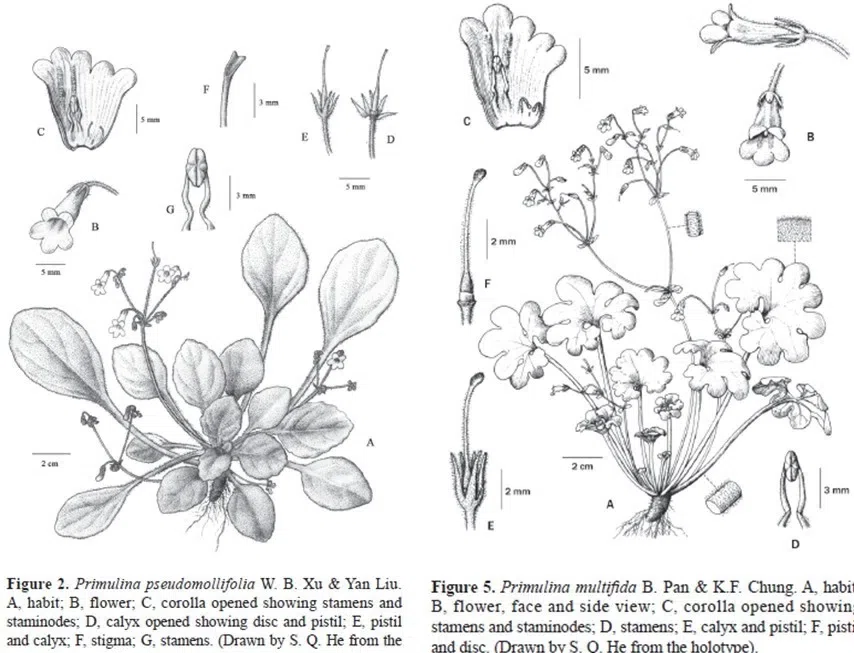
The newest published taxa of Gesneriaceae of China and/or nearby areas before 31 December, 2012
2016-03-23
New taxa in China
Got Any Question?
If you are having any questions, please feel free to ask.
Drop Us a Line

Hot news
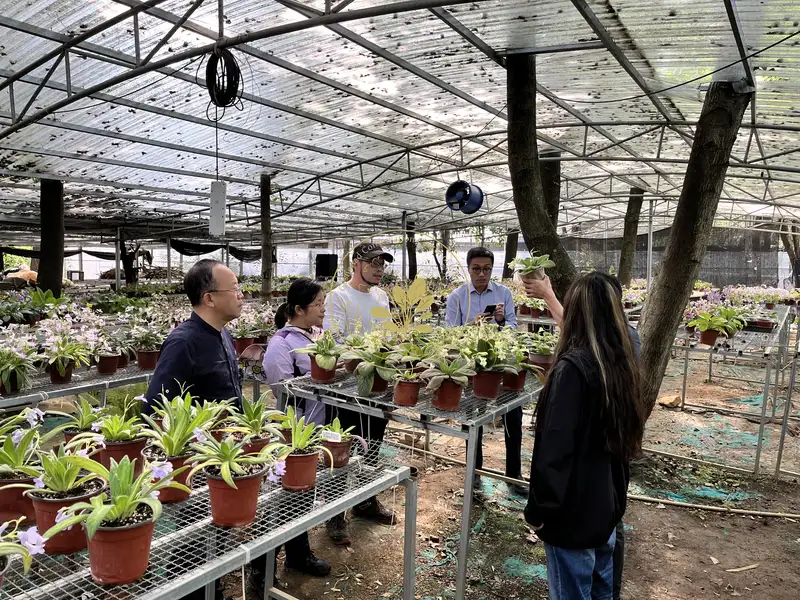
Popularization of Science
National Forestry Experts Review 6 New Guangxi Primulina Varieties

Field investigation
Field investigation in Duqiao Mountain, Rong County

The spirit in the crevices of Karst rocks — the standout among the Karst flowers, the ornamental plants of the Gesneriaceae family are in full bloom!

Field investigation
Field investigation of Primulina gueilinensis
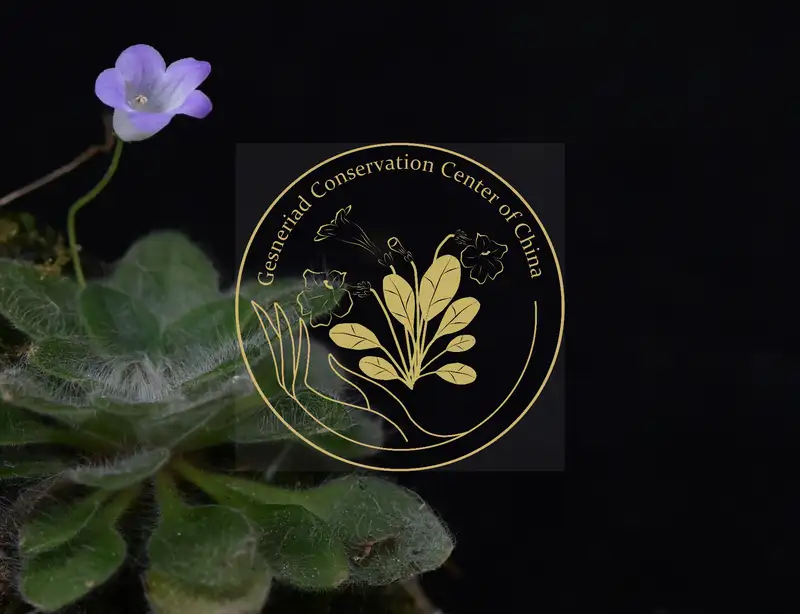
Field investigation
A field investigation of a new species, Primulina longanensis, of the Primulina genus from the Long'An County of Nanning city
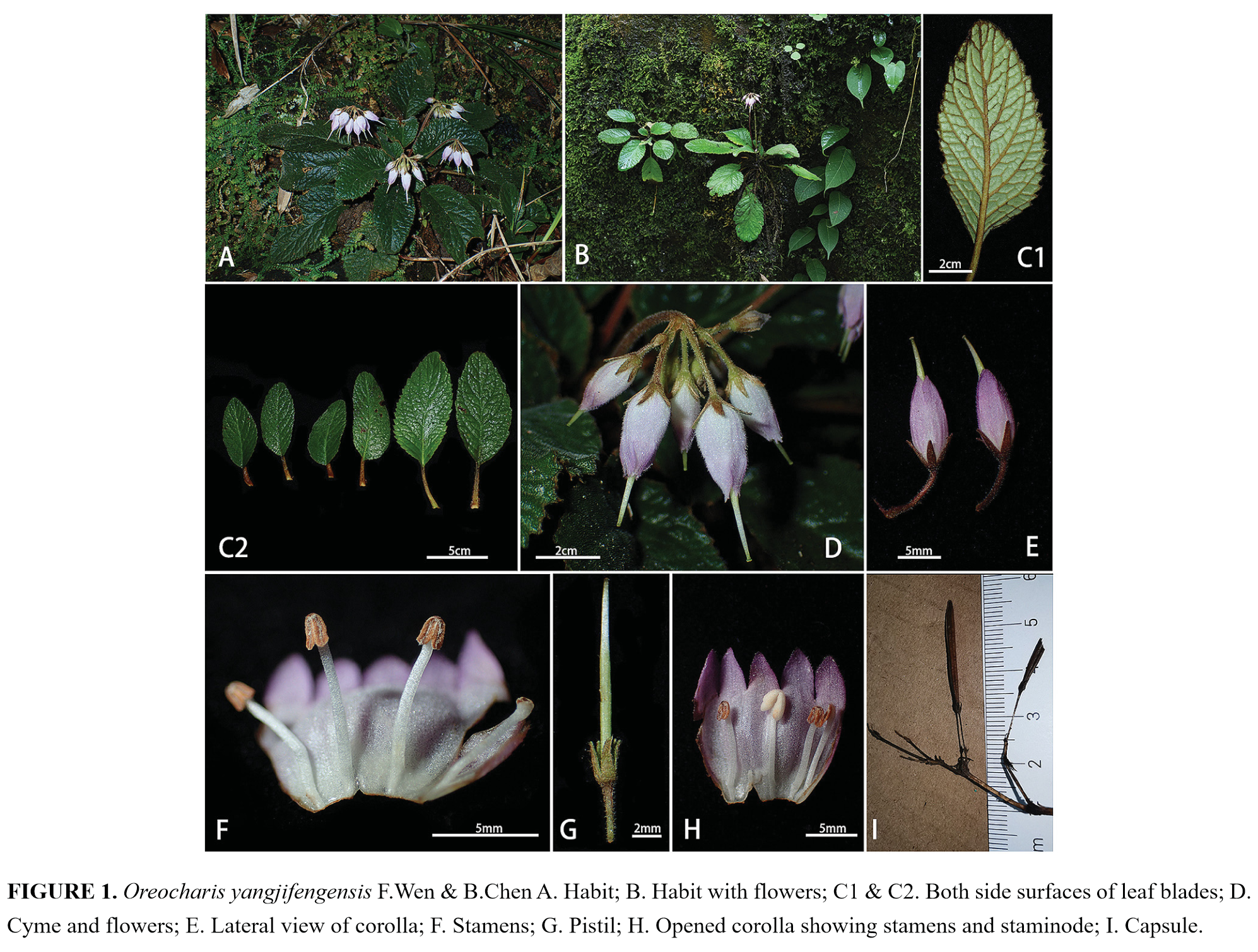
New taxa in China
The recently published new taxa and new records of Gesneriaceae from China before 31 December 2023 (4)
